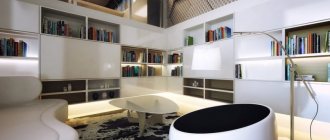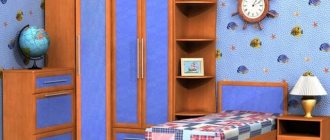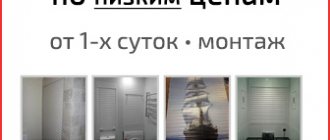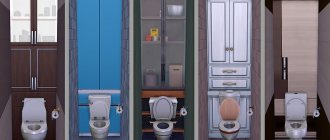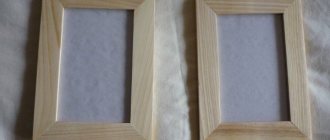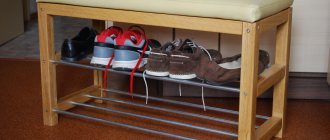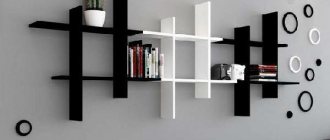Icer
8444 0 0
Icer August 5, 2016Specialization: master in the construction of plasterboard structures, finishing work and laying floor coverings. Installation of door and window units, finishing of facades, installation of electrical, plumbing and heating - I can give detailed advice on all types of work.
Have you ever thought that the space in the toilet is used irrationally? That is why I will tell you how to make shelves in the toilet with your own hands - at minimal cost, without the use of complex equipment. You don’t need to have the skills of a professional builder, just follow all the recommendations from this review - and within an hour or two, a lot of useful space will appear in your toilet.
In the photo: using the shelf you can also close the sewer riser
Reasons for the popularity of the design
The high interest in the new possibility of decorating bathrooms and toilets is explained by the fact that in modern bathrooms it is customary to hide everything “extra”
In addition, in most apartments these rooms are small, so it is very important to use the space rationally
Usually, at the same time as the construction of the cabinet, the communications behind the toilet are closed. The hanging compact is attached to a metal frame covered with plasterboard. Pipes, a counter, and a drain tank are hidden behind the wall, which allows you to gain valuable centimeters. Then the plasterboard slabs are tiled.
Disadvantages of the design include labor-intensive installation and increased workload when renovating or renovating a bathroom. It is also more difficult to get to communications. To provide access to them, a hatch is mounted in the bottom shelf.
In the photo: design by studio "DD"
Accessories
The service life of the entire structure, including doors, largely depends not only on the mode of use of the cabinet, the raw materials from which the products are made, but also on the quality and strength of the fittings used to fasten the elements and provide quick access to the interior of the cabinet.
Most often, the following additional elements are purchased to equip plumbing cabinets.
- Hinges for fastening the doors are the main part that holds the entire mass of the door. Such fittings regulate the issues of opening and closing. Since condensation can often accumulate on the pipes inside the cabinet, the hinges should be made of stainless alloys, which will extend their service life;
- Closers that provide fixation and smooth closing of doors. This fittings are installed in cabinet models with hinged doors;
- When installing roller shutters as structural doors, it is worth selecting models with an internal frame that will be attached inside the structure. The laconicism of the entire structure in the interior depends on this nuance;
- Secret-type doors are equipped with locks and various latches; you should carefully select such fittings, since the possibility of uninterrupted access to communications located in the cabinet will depend on its serviceability;
- To increase the tightness of the shutter closures, they are sometimes additionally equipped with furniture magnets.
Choosing a color scheme
Traditionally, neutral shades close to pastel colors are preferred in the bathroom and toilet. However, modern materials allow you to choose absolutely any color scheme. The plumbing cabinet in the toilet must comply with the same rules.
Light plastic doors, successfully matched to the color of the ceramic tiles
Dark doors in contrast to the finish of the plumbing unit
The main thing is not to forget about the rules of combination when choosing shades for your design:
- Combine warm shades with warm, cold with cold.
- Use 1 main color and 2-3 shades of it.
- Maintain balance in color combinations. If you choose bright colors, balance them with discreet elements.
- To avoid making a mistake when choosing a color scheme, use the color combination table.
The technique of combining contrasting colors is relevant. In a light-colored toilet, doors can become a bright accent. Or, on the contrary, to decorate the doors you can use the same color scheme as in the entire toilet, so as not to attract attention to the cabinet and make it invisible.
Louvered swing doors with beige tiles
Corner shelves
If you are a fan of original design solutions, then you can make a corner shelf for your bathroom with your own hands; it is not difficult and will not take much time.
To work, you will need a piece of plywood, a jigsaw, a screwdriver, self-tapping screws, a level and a pencil with a tape measure. To attach the finished shelf to the wall, it is advisable to use hidden fasteners that will be located on the walls that will be adjacent to the wall.
Making an original corner shelf for your bathroom with your own hands is actually very simple.
First you need to draw a circle on a piece of plywood or other material from which you want to make a shelf. To do this you will need a simple pencil and a piece of rope. If the piece has an even square shape, then you must first draw diagonals on it. These marks will be needed in order to later divide the circle into four equal parts. Next, drive a small nail into the center, to which a piece of rope is tied. A pencil is attached to the other end, with which a circle is drawn.
Next, the circle is cut out along the marks and divided into four even parts. One of the parts needs to be made smaller, since it will be the top shelf. To do this, you just need to attach a rope with a pencil attached to the sharp end to correctly trace the semicircular shape. After this, the part is simply cut off according to the mark.
And at the end, the workpieces are fastened together, two large parts are attached vertically to the bottom piece. Above, parallel to the bottom board, a reduced piece of a circle is attached. That's it, the DIY bathroom shelf is ready. It is enough to simply paint and decorate it.
A corner shelf is easy to make, but at the same time it can decorate almost any interior. The most important thing is to hang the wooden object in such a way as to prevent moisture from getting on it. Otherwise, just special impregnations to protect against moisture are enough.
Cabinet in the toilet behind the toilet (30 examples with photos)
A cabinet in the toilet is necessary for proper organization of space, for functional and aesthetic purposes. In small bathrooms it is most often installed behind the toilet, this way it will be possible to fill the area as comfortably as possible. In this article we will tell you what types of cabinets there are and give examples of real interiors.
Freestanding models
The design mainly consists of open shelves. The advantage of this option is convenient access to things and the ability to hide some items behind the facades. The downside is that you need to constantly maintain order.
The cabinet takes into account the shape and dimensions of the toilet. This model can be found in showrooms or made to order. Or do it yourself: all you need is furniture panels, timber and fasteners.
Neoclassical-style furniture fills the entire wall space and forms a spacious storage area in the toilet.
The metal rack is compact; for such a design, the model of the toilet is unimportant. Decor and household items are stored on glass shelves.
The cabinet does not take up much space, but is quite spacious - ideal for a small bathroom. Frosted glass fronts hide the contents of the shelves.
Wall cabinets
A universal option that is presented in any store. The dimensions allow the module to fit even into a miniature space and hang it behind the toilet at the desired height.
Mirrored doors create a deceptive effect of extending the room. However, fingerprints remain on the surface, which must be constantly removed - the main disadvantage of this model.
The matte surface perfectly camouflages objects. During operation, you will not have to clean the inside of the cabinet every day.
The lighting and black tint make the cabinet weightless, its outline literally disappears into the room.
Bright toilet interior. Color accents include red painted roller shutters, plumbing boxes and photo frames.
Open niches
In this case, the niche performs a decorative function. The relief of the uneven surface and the contour of the recess are emphasized by spot lighting.
Diversity in a monochrome interior is achieved through the play of light. Volumetric decor fills the recess in the wall and casts interesting shadows.
An open niche laconically complements the minimalism in space.
Niches covered by a facade
Toilet interior in vintage style. The color of the doors is in harmony with the shade of the tiles.
The façade material is painted white. The doors are fixed flush with the installation box.
The built-in wardrobe looks compact and provides access to communications. This, by the way, can be done very cheaply with your own hands.
White roller shutters do not stand out against the background of white walls. Despite the color division, the interior is perceived as one.
The wood texture of the floor, cabinets and doors goes well with green ceramics.
The wenge door hides access to communications.
Ceramic finishing of the inspection hatch. In the closed position, the contour of the niche is almost invisible.
Built-in wardrobe, which is closed by furniture roller shutters.
Access to the water heater through the inspection hatch.
Other options
Wicker baskets are suitable not only for towels: your cat will appreciate such a house. If in principle it doesn’t bother you that she will watch you.
The geometry of the room gives ideas for design. In this case, open shelves are not only useful for household purposes, they also visually straighten the wall behind the toilet (suitable for crooked walls!).
Combined option - open and closed shelves.
A mirror-cabinet allows you to use the wall space to the maximum functionally.
Shelving above the toilet: convenient, practical and affordable
Today, easy-to-install and very compact racks that are placed above the toilet have become quite popular. Their peculiarity is that they have stable legs, and the shelves start higher, above the toilet cistern. Such racks can also be open or closed, many of them are equipped with doors. In particular, among wooden shelving you can find closed models.
Metal racks look more elegant; openwork ones, with all kinds of curls, are especially interesting. But there are also very simple folding models with shelves. This is a simple budget option, but it is no less effective in terms of solving the storage issue in the bathroom.
Rack
The storage rack in the toilet combines the functions of open shelves and a built-in wardrobe. It doesn't take up space and can accommodate jars, drawers, boxes, towels and all kinds of small items. The shelving unit in the toilet holds everything you need for this room, and sometimes even more; it is quite possible to organize a storage area for a mop, brushes, buckets, etc.
Special racks
Complete toilet storage system.
So that owners of small apartments do not feel discomfort and do not rack their brains about how to organize storage in the toilet, modern furniture brands have developed many convenient multifunctional storage systems. Today you can find many original toilet sets in a variety of styles. For example, an elegant metal shelving unit would be suitable for a classic-style toilet, a laconic white set would easily fit into a Scandinavian setting, and stylized wooden models would be appropriate for a rustic style.
Stylish model of a toilet cabinet.
Just what you need for a small toilet.
Neat storage in the toilet.
Materials for the manufacture of sanitary cabinets
The choice of material for making a cabinet is influenced not only by its purpose, but also by the overall style of the toilet room. There is a large selection of materials and components on the market, all that remains is to decide on the choice.
Drywall of moisture-proof grades allows you to make a cabinet of various designs for painting, decorating with any finishing materials, drawing, decoupage, etc.
Plywood and chipboard are suitable for making facades. Plywood facades can be carved, and chipboard can imitate wood; they require good ventilation to protect them from moisture. Plywood should be treated with antiseptics, painted, stained or varnished.
Wood is well suited for making shelves as it does not sag under heavy loads, but also requires good ventilation. Wood requires stain or varnish
The tiles are used for cabinets hidden in niches and are fixed on a specially made frame.
Mirror canvases are well suited for visually enlarging rooms.
Plastic is a lightweight material suitable for making doors. You can use ready-made wide cladding panels.
Metal profile or corner for making a frame (aluminum or galvanized).
Wooden bars for the frame, treated with antiseptic. Ready-made purchased facades, doors, hatches, ventilation grilles.
Tools for work: tape measure, level, screwdriver, drill, saw, hacksaw, pencil.
Accessories: stainless steel hinges, screws, corners, door closers, furniture magnets, door handles, roller door frame, etc.
Before work, you need to decide on the depth of the cabinet, the height of the shelves, the location of the doors and the method of their fastening. The average cabinet depth is 25-35 cm.
The cabinet frame is assembled from metal corners or wooden blocks. The location of the shelves is marked, which should not come into contact with the pipes. Holes are cut in the shelves for the passage of pipes. At the end, facades, magnets, and handles are fixed.
Wardrobes for medium and large sized bathrooms.
Manufacturing process
There are different ways to rationally organize the free space behind the toilet.
Option 1: shutter shutter
The simple design involves the installation of 3 shelves and ordinary window blinds, which will hide the contents of the cabinet from prying eyes.
A simple option: shelves behind the blinds
Table 2. Step-by-step installation instructions.
| Illustration | Description |
Step 1 | On opposite walls, guides made of a metal profile 280 x 270 mm are fixed. |
Step 2 | A profile of 600 x 270 mm is installed between the guides. |
| Step 3 | The profile is installed horizontally. |
Step 4 | The metal elements are fixed together using screws, having previously drilled a hole for them. |
Step 5 | Markings are applied to the wall to indicate the location of the profile. |
| Step 6 | To fix the profile on the wall, pre-drill a hole using a hammer drill. |
Step 7 | The profile is fixed with dowel nails. |
| Step 8 | Crossbars cut from the profile are installed below. |
Step 9 | Metal corners are fixed under the shelves on the wall. |
Step 10 | To fix the corners, dowel nails are used. |
| Step 11 | Liquid nails are applied to the back side of the starting profile. |
Step 12 | A small amount of liquid nails is applied to the surface of the guide. |
Step 13 | The starting profile is glued. |
| Step 14 | To ensure a tight fit of the starting profile and its reliable gluing, the bar is additionally secured with paper clips. After the part is glued, the paper clips are removed. |
Step 15 | The riser pipe will be covered with PVC plates. To do this, measure the distance between the guides. |
| Step 16 | The panel is cut out and installed in the starting profiles. |
| Step 17 | Using a jigsaw, shelves of the required width are cut from laminated chipboard. |
Step 18 | The shelves are fixed to the corners. |
Step 19 | Blinds are ordered according to individual sizes. |
Step 20 | The blinds are applied and the points for the holes are marked. |
Step 21 | A hole is drilled at the marked point. |
| Step 22 | Fix the fasteners and hang the blinds. |
If the length of the blinds is too long, the excess slats can be easily removed
If it turns out that the blinds are too long, then proceed as follows.
Table 3. How to adjust blinds to size.
| Illustration | Description |
Step 1 | They pull out the rivet. |
| Step 2 | Cut the thread. |
Step 3 | After removing the excess slats, the finishing strip is installed in place. |
Step 4 | Tie a knot and place a decorative rivet. |
Option 2: wall cabinet
To make a wall cabinet, you will need to take measurements of the room, make a drawing, and determine the quantity and dimensions of all parts.
Wall cabinet without back wall
Table 4. Step-by-step instructions for installing a wall cabinet.
| Illustration | Description |
Step 1 | You can cut the parts yourself or order it from a furniture shop that provides a similar service. |
Step 2 | To assemble the cabinet, you will need to purchase mounting tools and other accessories. |
| Step 3 | Work begins with preparing the holes. |
Step 4 | First use a 2 mm drill, and then drill the hole with a 5 mm drill. |
Step 5 | Holes are also made in the end parts of the panels. |
| Step 6 | Assembling the frame. |
| Step 7 | Holes are drilled to fix the central strip, which will divide the frame into two parts vertically. |
Step 8 | Drill holes and insert shelf holders. |
| Step 9 | The shelves are fixed using confirmations. |
| Step 10 | Determine the location of the handles. |
Step 11 | Drill holes for dampers. |
Step 12 | Drill recesses to fix the hinges using a Forstner drill. |
| Step 13 | Fix the loops. |
Step 14 | The hangers are secured with glue and self-tapping screws. |
Features of selection and location
A few things to choose from:
- The cabinet is selected according to the size of the room. For example, for a small toilet room in an apartment, small structures or narrow models located above the toilet are better suited.
- In a spacious toilet combined with a bathtub, you can install a larger hanging structure, a cabinet or a pencil case.
- You should not choose products that are too wide and will hang over your head. The most optimal and harmonious option are cabinets with a width of 20 cm.
- It is also undesirable to save on accessories and prefer high-quality and proven products.
Variety of materials
The shelves should be durable and wear-resistant and not afraid of washing. Popular materials are as follows.
Drywall. The universal material allows you to create structures of any kind. Usually mounted on a metal profile for strength. When making it yourself, you first need to prepare the frame, and then attach sheets of drywall of the appropriate size. The surface is leveled with putty, then you can start decorating.
Tree. Only high-quality material is used, boards without stains or deformations. Before making wooden shelves, you must carefully sand the surface. Be sure to varnish the boards so that they do not suffer from external influences. The stain will allow you to change the shade of the wood, and the burner will give the effect of antiquity.
OSB. The sheets are much stronger than the previous version. It will not be possible to decorate products with carved monograms; the material crumbles. OSB boards have an interesting pattern, so you can not paint them, but simply varnish them or use stain, as is the case with wood.
Metal and glass. The fastenings are made from the first material, and the shelves themselves are made from the second. It is worth choosing glass at least 6 mm thick. Otherwise, the structure will not withstand the load and will quickly break. Fastenings can be purchased at a hardware store, and glass of the required size can be ordered at a workshop.
It is important to space the supports evenly. Metal shelving can be used without glass
It is convenient if they are equipped with wheels and can be moved at will. Cleaning the structure is very easy. The only drawback is the heavy weight.
Plywood. Shelves can be made from material 6-10 mm thick. It is noteworthy that plywood bends and allows you to create intricate shapes. You can make a shelf for your phone or magazines from plywood 4 mm thick. Self-tapping screws of suitable size are used for fastening.
Plastic. You won’t be able to make such a shelf yourself, however, stores offer a wide range of different sizes and designs. You can additionally decorate with paint or self-adhesive paper. A fairly budget option that is not afraid of high humidity.
Purchased shelf option
The stores offer a large assortment of corner and classic shelves of all sizes and colors. The most inexpensive option is a shelf system made of plastic. Such shelves are quite practical, but their appearance leaves much to be desired. Over time, the plastic loses its appearance and becomes stained, which is very difficult to clean. Scratches and abrasions make plastic shelves on the wall in the toilet unusable quickly enough.
READ MORE: How to make a niche for a TV from plasterboard with your own hands
Metal chrome shelves are a good option for a toilet. They do not look bulky and give the interior of the toilet some zest. The remaining parts of the room can also be decorated with the addition of chrome elements. The price of such shelves is a little higher, but it is quite affordable for the average resident of Russia.
Store-bought glass shelves are very difficult to find. If your toilet does not have any pipes that come from neighboring apartments, and the wall space is empty and flat, then you can use purchased glass shelves.
Material
Having decided on the type, location and additional functions of the cabinet, you need to select the material from which it will be made. This issue must be approached very responsibly. There are several options for cabinets depending on the materials from which they are made:
Wooden
Wood is a classic material for making furniture. Many connoisseurs of natural materials will undoubtedly appreciate furniture made from solid wood. But, unfortunately, it has a fairly high cost, so it will not be available to everyone.
Such furniture must be covered with a protective coating, such as varnish or paint, to protect it from environmental influences.
From pressed slabs
They are made of chipboard or MDF. It is necessary to take into account that this material does not tolerate moisture very well, but it has a much lower cost compared to wood. In addition, at high temperatures, these materials release substances harmful to the human body. They are most often covered with paint and varnish coatings, which gives them an aesthetic appearance and protects them from external influences. Despite all the disadvantages, this option is very popular due to its availability and low cost.
Plastic
Nowadays, plastic is a very common material. It is very convenient for the bathroom, as it tolerates humidity and temperature differences well, besides, it is lightweight and does not require additional care. Plastic products are the cheapest option. Cabinets made of plastic can have a wide variety of shapes, colors and surface options.
Metal
Metal does not like contact with water. In this case, it begins to oxidize and rust. Therefore, this material is not very popular for placement in the bathroom. The only option for such a material that is convenient to place in bathrooms is forging. Forged products look very beautiful and add chic to any room. But since most often they are open, they serve more as decoration. Beautiful tubes, towels or decorative figures look great on them.
Glass
This material tolerates high humidity well. Cabinets made from tempered glass are very durable. They have rounded corners, which helps reduce injuries.
This option is great for small rooms, as it visually gives it more space. Perhaps the only drawback is that all content is not hidden from prying eyes. But this can also be avoided if you purchase models made of frosted or tinted glass.
From plasterboard
This type of material is used for built-in cabinet models, which can be made with your own hands and covered, for example, with paint or even ceramic tiles.
The choice of material is of great importance for the bathroom, since it has special environmental conditions that negatively affect the products. Therefore, you need to approach the issue of choosing material for a bathroom cabinet with great responsibility.
Dimensions
The sizes of bathroom cabinets can be completely different. Therefore, it is always possible to choose a suitable cabinet for any room.
Wall cabinets can be small, up to 15 cm deep. This option, of course, is not particularly spacious, but is excellent for the necessary hygiene products for everyday use.
When it comes to cabinets, they most often have a narrow design, their width is 20 cm or more. Many people like to place them in pairs on both sides of the washbasin.
There are no size restrictions for a wardrobe. The main thing is that it does not take up too much space in the bathroom, which will create significant inconvenience.
Colors
The choice of color for bathroom furniture is limited only by the imagination of the homeowner, because on the modern furniture market you can find everything you want. It is better, of course, to follow the color scheme of the decoration and furniture, then the interior will look more attractive.
Some people prefer bright and catchy furniture or even noble dark shades.
If the exact color you need is not in stock, you can always order the desired product. Of course, it will take some time to make, but it will have an individual design and will fully meet your requirements.
Design of a small toilet with a cabinet
A small toilet room is equipped with narrow shelves that take up space above the toilet barrel, or a side wall or mini-models, with open or closed shelves that look very harmonious and neat.
Quite often they use products with mirrored facades, which make it possible to visually increase the dimensions of the room. Such cabinets do not contribute to cluttering the space, give the atmosphere a special lightness and allow you to radically change the design of the room.
Design of a toilet in an apartment - 7 rules
It would seem where you can mess up in a room as small as a toilet. But in such an area everything is visible, every detail matters. Let's figure it out.
We recommend: Firewood, coal, fuel briquettes, what to heat with
Toilet - wall-hung only
This is the first most important and ironclad rule - only a wall-hung toilet with installation. Without it, you don’t even have to think about toilet design. Even the most expensive and sophisticated floor-standing toilet is inferior to a wall-hung one in all respects. Differences:
- Only the wall-hung toilet has a modern appearance.
- There is no ugly silicone joint with the floor or a gap between them.
- Because visually the area of the room is estimated by the floor, but the suspended floor does not occupy it, the area seems larger.
- Convenient to clean. Dirt does not accumulate behind the toilet and at the joint.
- Effectively takes up less space.
A modern toilet design without a wall-hung toilet is impossible. This is the thing on which saving is unacceptable.
Some photos will show regular floor-standing toilets - this is a mistake. These photos are here to illustrate other ideas, I will not return to this.
Hatch in the toilet
This is the second point, without which the toilet design will be of a very low level. The worst thing you can do is use a ready-made white metal hatch. This is a purely rough technical solution, which is unacceptable in the design of a toilet in an apartment.
Correct ways to hide pipes and meters:
- Hidden hatch under the tiles.
- Furniture doors.
- If inexpensive - a painting or a printed photo, a panel, a roller blind.
The latter can be done very inexpensively. And this is already better than a white hatch. Be sure to hide the pipes properly. It is on such nuances that the design of the toilet is built.
Please note that the hidden hatch under the tiles will have dark gaps around the perimeter. To prevent this from being noticeable, the grout of the rest of the tiles should also be dark.
No more than 2 colors
The toilet is white. Those. There is always 1 color already. There should be no more than two colors that strongly contrast with white. Otherwise there are too many details for a small toilet without a bathroom. The exception is patchwork and other non-aggressive mixtures, where colors do not dominate and do not attract attention.
I love dark and black colors in the interior, but not in the bathroom, toilet and kitchen. On average, the design of a small toilet looks advantageous in light colors. Everything else is an unjustified risk.
White, beige, gray, wood shades are the best colors. I wrote in detail in an article about the design of small bathrooms.
Small sink
There are very small sinks specifically for toilets. Being able to wash your hands is very important for a toilet without a bathtub. Otherwise, we come into contact with the door handles of two rooms at once just to get to the sink.
They are so miniature in size that in width they occupy little more than part of the wall with the platband. This is not a design issue, but for practicality I recommend it.
Decorative lighting
There is no need for a bright overhead light in the toilet. We do not need to look at ourselves in the mirror or perform any hygiene procedures. This means you can make decorative lighting and use it as the main one.
One of the modern ideas for renovating bathrooms in 2022 and for the toilet too is to place light sources at the bottom and middle of the room, making them hidden. With this arrangement, they provide a lot of shadows and the interior looks not boring, but at the same time strict. The more textured the tile, the more voluminous and interesting it will look. There are a million ways to embed LED strips, special profiles with a diffuser screen, etc. You can find a place for them even on an area of 2 sq.m.
Brush holder on the wall
Yes, such a small thing. There are very few objects in the toilet and each of them affects the overall perception of the interior. And such things as a brush are usually left for the last minute and bought “temporary”. Which then, of course, last for years. Just buy a normal one right away and hang it on the wall.
Toilet larger than 2 sq.m.
2 meters is more than enough space for a toilet and is exactly the size in most apartments. That's why all the rules and photos are about them. If your toilet is larger, then it makes sense to place additional items there, otherwise the space will be used irrationally.
Candidates for entry: bidet and pseudo-bidet, washing and drying machines, boiler. If the toilet is still small, here’s how to place a washing machine in the bathroom.
Nuances when installing a shelf
If you have enclosed water pipes in the cabinet, the shelves should not touch them, see photo. Usually the pipes are not positioned strictly vertically, so each shelf will have to be “processed” individually. If the pipes have a small diameter, then the holes in the shelves are made using a feather drill, then you need to take a jigsaw and cut the shelf so that it touches the wall closely.
A hole for the fan pipe is cut with a jigsaw, but before that you need to drill the shelf, this is necessary in order to pass the jigsaw file through it
It is important to determine the size of the hole as accurately as possible so that the files are in place
It is not necessary to firmly attach the shelves to the profile, as you may need a place to store tall objects. A loose bottom shelf is often used for easy access to meters and valves on pipes. Loose shelves are the easiest way to gain access and do not require the installation of additional hatches and doors.
How to make a corner shelf?
Ideal storage systems for a small toilet.
If the toilet area is very limited, then wide open shelves will simply be inappropriate. Here it is worth thinking about how to take advantage of unsightly corners. Several rows of open shelves of non-standard size - already ordinary ones - will fit well here. They are convenient for storing toilet paper, cotton pads in glass jars, detergents and cleaning products.
To save space in the house, corner shelves are often used. They look more modern and practical. And note, you can embed them anywhere.
The manufacturing process, in essence, does not differ from that described above, but there are some peculiarities. One of them is that the upper and lower parts are made up of two elements with the ends cut at the desired angle.
Then the process is carried out like this: first, the two parts of the top are glued together and clamped for a while. Do the same with the bottom beam. Polish, cover with a primer mixture and fasten according to the algorithm written above.
That's it - the work is almost the same, but a new, convenient, practical product is already appearing.
The main purpose of the cabinet in the toilet: types of designs
The toilet in an apartment or house is considered one of the most important rooms, so its arrangement should be approached carefully to create a truly comfortable area
If you look through photos of toilet rooms, you will notice that not a single room is complete without a closet or at least a small cabinet, which serves as convenient storage for necessary things
The cabinet provides an opportunity to create additional storage space for household chemicals and other cleaning accessories
This piece of furniture performs certain functions in a given room.
Using a cabinet, you can aesthetically hide communications. Open sewer and water pipes can only decorate such a specific style as a loft. If you plan to create a classic interior, then with the help of a cabinet you can carefully hide communications
At the same time, it is important that access to pipes and connections always remains free, so that in the event of an accident they can be easily reached
Modern bathroom cabinets vary in appearance and performance characteristics
This piece of furniture will help to properly organize the room. A well-thought-out built-in closet in the toilet will become a place where household chemicals and other cleaning products will be stored. This method allows you to rationally use the entire area of even a small bathroom in an apartment with a small area.
In addition to the fact that using a cabinet you can hide the pipes, you can also carefully disguise the water meter in the same way, while maintaining the aesthetics of the interior. There are many positive aspects of using additional cabinets in the toilet; the main thing is to choose a quality product that will complement the room, but will not clutter it. There are the following main types of toilet cabinets:
- the entire wall to the ceiling. This option not only hides communications, but also contains a lot of space for arranging necessary things. Shelves can be made stationary or retractable;
- small hatch. Mainly used to hide plumbing connections and meters, but in this case there will be no space left for storing items;
Hiding communications is the main task of the closet in the toilet
hatch for a sanitary cabinet in a medium-sized toilet. Mostly located behind the toilet. In this situation, in addition to closing the pipes, there is still space for installing several shelves. The size of such a hatch usually does not exceed 50x70 cm.
Depending on the type of structure, the following types of cabinets are distinguished:
- Products with legs, the width of which should not be less than the width of the tank. Located behind the toilet.
- Wall cabinets for the toilet. They can be either built into a niche or hanging over the toilet.
- Full cabinets built into the niche. Furniture not only allows you to hide communication systems, but also makes it possible to store a large number of household items.
- Built-in shelves. Installed if there is a niche in the room. They can be left open, but it is better to use cabinet doors in the toilet to make the room look aesthetically pleasing.
Models of bathroom cabinets can be easily selected for any style, taking into account dimensions and color
Built-in wardrobe
The most accurate option. Sometimes the built-in closet in the toilet behind the toilet is difficult to notice even in the photo. But this is also the most difficult technique to implement; it needs to be designed at the repair stage. In fact, built-in models are a niche.
What to make a niche from?
- Moisture-resistant drywall is one of the suitable materials for implementing such an idea. Waterproof and wear-resistant, it will reliably protect the contents from splashes of water and force majeure. It is tiled or painted.
- Plywood options are cheaper, but they will last much less.
Built-in models look best with wall-hung and wall-mounted toilets. This combination can be easily decorated in any style, including minimalism.
The most important thing in built-in cabinets is the design of the door; in fact, it is the only visible element. And here there is wide scope for creativity.
Which doors to choose?
- Wooden doors of the louvered type look great in a simple style such as scandi or eco. Painted, they will fit into a modern interior.
- Doors made of natural wood are universal in themselves. They can also fit into a Scandinavian, minimalist, or modern interior. Be careful with such solutions in bathrooms combined with a bathroom. If the toilet is located next to a shower or bowl, the wood must be treated with varnish or a similar moisture-resistant coating.
- “Invisible” doors, the design of which matches the finish, can fit into any style. They are decorated with tiles, plaster and wood panels.
- A mirror is a controversial technique in decorating a toilet. Agree, even tiny bathrooms with an area of less than 1.5 m do not need to be expanded, it is not functional. Plus, the coating is fragile and not practical.
We recommend: Concluding contracts for garbage removal, snow removal and territory cleaning
In modern design, the principle of color blocking is often used - highlighting color spots. This technique is especially relevant in bathrooms combined with a bathroom. The area around the plumbing fixtures is highlighted with color: the niche and cabinet are painted.
In niches you can often find a combination of a closed cabinet and open shelves. This is a good solution for wide walls. In this way, designers add “air” so that the place does not look overloaded and boring.
Shelves can be equipped both vertically on the side and horizontally - directly under the doors. In both cases, the illumination of these zones looks very impressive. Often, a built-in model is combined with a plumbing cabinet in the toilet behind the toilet: communications are hidden behind the doors and additional storage shelves are installed.
Bathroom Remodel: 6 Do's and Don'ts
Design and color scheme
The hanging cabinet for the bathroom is available in a variety of colors. The most common are light shades. It is best if the color of the furniture matches the main colors of the interior. If there are other objects in the room, then their color should be in the same color palette. In addition, the right color can create a good mood.
If the room is made in white colors, then the bathroom cabinet with a basket can be blue. This combination of shades will give the room freshness and comfort. Green tones create a relaxing and peaceful atmosphere. If the interior is made in black or brown colors, then you can choose a bathroom cabinet with a laundry basket in richer colors. For a classic style, a wenge shade and darker noble colors would be appropriate. A bold decision would be to use yellow and orange colors, which make the environment more lively and sunny. Blinds for the sanitary cabinet in the toilet are suitable for the minimalist style.
Criterias of choice
The toilet cabinet is selected in accordance with the design of the room and the required dimensions. When choosing a model, you need to consider the following:
First you need to decide on the shape of the structure. If the room has a niche, then it is best to purchase a custom built-in wardrobe. You can buy the cheapest ready-made products; It is first necessary to measure the space so as not to make a mistake with the dimensions of the structure. In addition, you also need to measure the dimensions of the pipes, which should be completely hidden in the closet
Before going to the store, it is best to draw a diagram of their location; you need to choose the appropriate color and design of furniture so that it harmoniously complements the toilet; before purchasing, you must familiarize yourself with the quality certificate for the design, which will guarantee the long service life of the product, its reliability, and the good quality of the materials used; It is very important to inspect the available components and fastening elements. If there are no hardware or brackets, you must separately purchase the missing mechanisms for attaching the product to the wall surface.
It is also important to check the availability of fasteners and other components. Cabinets for the toilet should be harmoniously combined with the renovation in the toilet room, giving the room completeness and aesthetics! The toilet cabinet can be additionally equipped with a lock, mirrors, and lighting
The products are equipped with shelves and drawers to accommodate various items.
Plumbing cabinet
This design requires more financial costs, but pays off due to its functionality. Plumbing cabinets completely hide pipes, which do not add aesthetics to the interior.
A cabinet is also necessary if you are annoyed by the noise of water drained by your neighbors: the doors allow you to disguise the sound insulation. Built-in shelves provide storage space.
Features and Benefits
Small apartments suffer from a lack of storage space, but their washrooms are also small. Most often, there are no installations installed in them, the sewer pipes and cistern are in plain sight, the toilet is pushed forward, and between it and the wall there is an empty space that could practically be equipped with stationary shelves.
Furniture stores have a varied selection of shelves and hanging cabinets, but a small room requires efficient use of space. That is why it is better to make shelves in the toilet yourself, taking into account the specifics of the bathroom layout.
The advantage of such furniture is undeniable:
- many little things will immediately acquire their rightful place;
- the pipes will be hidden under an overhanging structure;
- with the help of shelves you can play up the design of the room;
- empty walls make it possible to fill them with different types of furniture: a hanging cabinet, an open shelving unit or shelves;
- small open sections in the access area will become a place not only for a book, you can put decorative items on them: scented candles, a figurine, a shell.
What are the doors made of?
For making doors, ready-made pieces of old furniture are suitable if their size matches the cabinet rail. In the absence of ready-made parts, they can be easily assembled yourself. Each prefabricated door consists of a frame (2x2 cm timber) and an insert into it. It is convenient to make one-piece models from sheet materials (chipboard or plywood).
Doors with lathing
Calculate the length and width of the product and cut 4 bars for the frame: 2 vertical and 2 horizontal. Connect the parts into a rectangle using corners and self-tapping screws on the wrong side. From the facade, the door is strengthened and at the same time finished with lathing.
The lathing can be made from parts of a decorative screen (for example, for radiators). This is a panel made of sheet material with holes, which can be easily cut and secured with screws around the perimeter of the frame. Other sheets are also used in the same quality: plywood, gypsum board, plastic, etc.
Louvre doors
To make your own blinds, you will need many thin strips of wood (plywood) or hard plastic. On the side vertical parts of the frame, parallel cuts of 0.5-1 cm are made at an angle
It is important to carefully mark both parts so as not to warp the blinds. After this, the frame is assembled, and strips are inserted into the cuts, securing each with glue
Finally, a finishing strip or shaped baguette is attached to the front side of the door around the perimeter, slightly overlapping the junction of the blinds and the frame.
Plumbing plastic hatch
A convenient option for a small cabinet is a ready-made inspection hatch. This product can be purchased in a store and installed in a false panel.
Plumbing hatch for tiles
A large hatch can be disguised as tiled panels. First, they assemble the frame and hang false wall panels on it, and then install the hatch. Finally, the wall is covered with the same tiles as the walls of the toilet. The material must be glued with a gap so that the increased distance between the edge of the hatch and the panels is noticeable.
Roller shutters
It is better to buy this product ready-made, with a lifting mechanism. It must be installed according to the manufacturer's instructions. The design is convenient in moving the curtains up and down: with this opening, the doors will not require space if the toilet is small.
Glass
Glass inserts are fixed in a frame or a sliding door system is mounted. For its simplified version, you can use plastic runners without a roller insert (it is not needed for a small door). Sliding glass in furniture walls is designed using this principle. If you cut the glass yourself, you need to sand all its edges so that they are not sharp.
Design
Choosing an interesting model of toilet cabinet is quite simple; you just need to decide which type will be best suited for a given room. Several models can be considered the most popular.
Cabinets with roller doors. Such furniture is often installed in a small room. The convenience of such models is that their roller shutters are raised, so the products can be hung in the most inconveniently shaped place.
Shelves can be either closed or open. For closed shelves, it is assumed that there are doors, which make the structure a little heavier. At the same time, a cabinet with a door will contribute to a more aesthetically pleasing appearance in the toilet, because sometimes the shelves can be cluttered, and closed shelves will hide this defect from view. Mirrors are often hung on doors, this creates additional convenience for their use.
In hardware stores you can find shelves and cabinets for the toilet for every taste, but they do not always correspond to the required size or do not fit a certain room.
In addition, building a cabinet with your own hands will cost less than a store-bought version; when performing the work, all wishes regarding size, type, color and material for manufacturing can be taken into account.
Near the toilet you can place a pencil case or a cabinet with shelves; such furniture is more suitable for large bathrooms. Often a roll-out drawer is placed near the toilet; this location is very convenient for getting the necessary thing out of there. If desired, you can cover the niche above the installation with plasterboard or cover it with a mirror.
When making a closet for a toilet, you should choose the most convenient and functional models; moreover, such a product should not stand out from the general color scheme. When choosing colors, it is better to give preference to delicate, pastel tones; they are perfect for a small room.
A cabinet made in contrasting colors will also look good in the toilet. Such an accent area will create the appearance of a spacious room.
Conclusion
Making shelves for a toilet is not as difficult as it seems at first glance, especially since there are a lot of design options. I haven’t considered everything, you can come up with a solution yourself, and who knows, maybe later I’ll talk about it as an excellent solution for the bathroom. The video in this article will clearly show some important points, and if something is unclear to you, please leave a comment below.
Did you like the article? Subscribe to our Yandex.Zen channel
August 5, 2016
Accessories, Bathroom and toilet design
If you want to express gratitude, add a clarification or objection, or ask the author something, add a comment or say thank you!
Materials
In addition to moisture resistance, there are other requirements for materials for the manufacture of bathroom furniture:
- resistance to mechanical stress;
- ease;
- aesthetics;
- environmental friendliness.
Natural wood is one of the most attractive and durable materials. In addition, they love it for its uniqueness - there is not a single repeating cabinet from the array, each one is at least a little different from the rest. MDF and chipboard are more budget options and, accordingly, less durable than wood. They are easy to process, making cabinets made from these materials very diverse in style, design, and available in a wide range of colors. Sometimes plywood, which is resistant to deformation and moisture, is chosen as the basis for the frame and facades. The thickness of the sheets must be more than 14 mm. The main advantage of plywood is its lightness, which ensures minimal load on the walls.
Functionality of cabinet partitions, furniture placement options
Like chipboard, OSB is a material made from wood panels, but chips of a special shape and orientation are used to make it. Due to this, it is 1.5–3 times stronger than chipboard. But what’s more important is that OSB can withstand being in even a very humid room.
The cladding options also differ. If you want to keep the cabinet in the toilet as a separate stylistic element, you can choose a model with mirrored facades, paintings, and 3D images. But sometimes it is more important to disguise the product as much as possible, to make it almost invisible in the room. In this case, models decorated with tiles that repeat the pattern of the walls are more suitable. Washable wallpaper is used for the same purpose.
The closet in the toilet is used as furniture for storage, masking counters and communications, as well as leveling the space - for example, in the presence of niches or awkward protrusions. This abundance of tasks corresponds to a variety of models in shape, design, type of doors, and materials used. False walls allow you to install a closet behind the toilet in the toilet, wall-mounted structures allow you to use the space above it, and corner walls cover the joints of the walls
When choosing, it is important to focus on the moisture resistance of the material and design - a cabinet can become both a bright and the most inconspicuous detail of the interior
Natural wood
MDF
Chipboard
Mirror
Glass
Tile
Shelf lighting
Spot lighting can be used as illumination. Small round lampshades are easily mounted in chipboard, OSB or plasterboard. A small border is made above the very top shelf. Behind it you can hide the wiring that will extend from the lamps.
An interesting lighting option is obtained by using LED strips. To connect them, you must use a special converter - a 12 or 24 W power supply. The choice of power supply depends on the type of tape. Nowadays there are LED strips that even connect to AC power from an outlet.
The tape pieces are attached with their sticky side to the bottom surface of the shelves and connected to each other by wires. The LED lighting switch can be placed in a location convenient for you. If you use a motion sensor, then the light in the toilet will turn on automatically when someone enters. All these interesting little things are impressive when they are arranged in a room such as a toilet.
